4WD TOYOTA 4RUNNER 2009 N280 / 5.G Owners Manual
[x] Cancel search | Manufacturer: TOYOTA, Model Year: 2009, Model line: 4RUNNER, Model: TOYOTA 4RUNNER 2009 N280 / 5.GPages: 520, PDF Size: 10.74 MB
Page 3 of 520
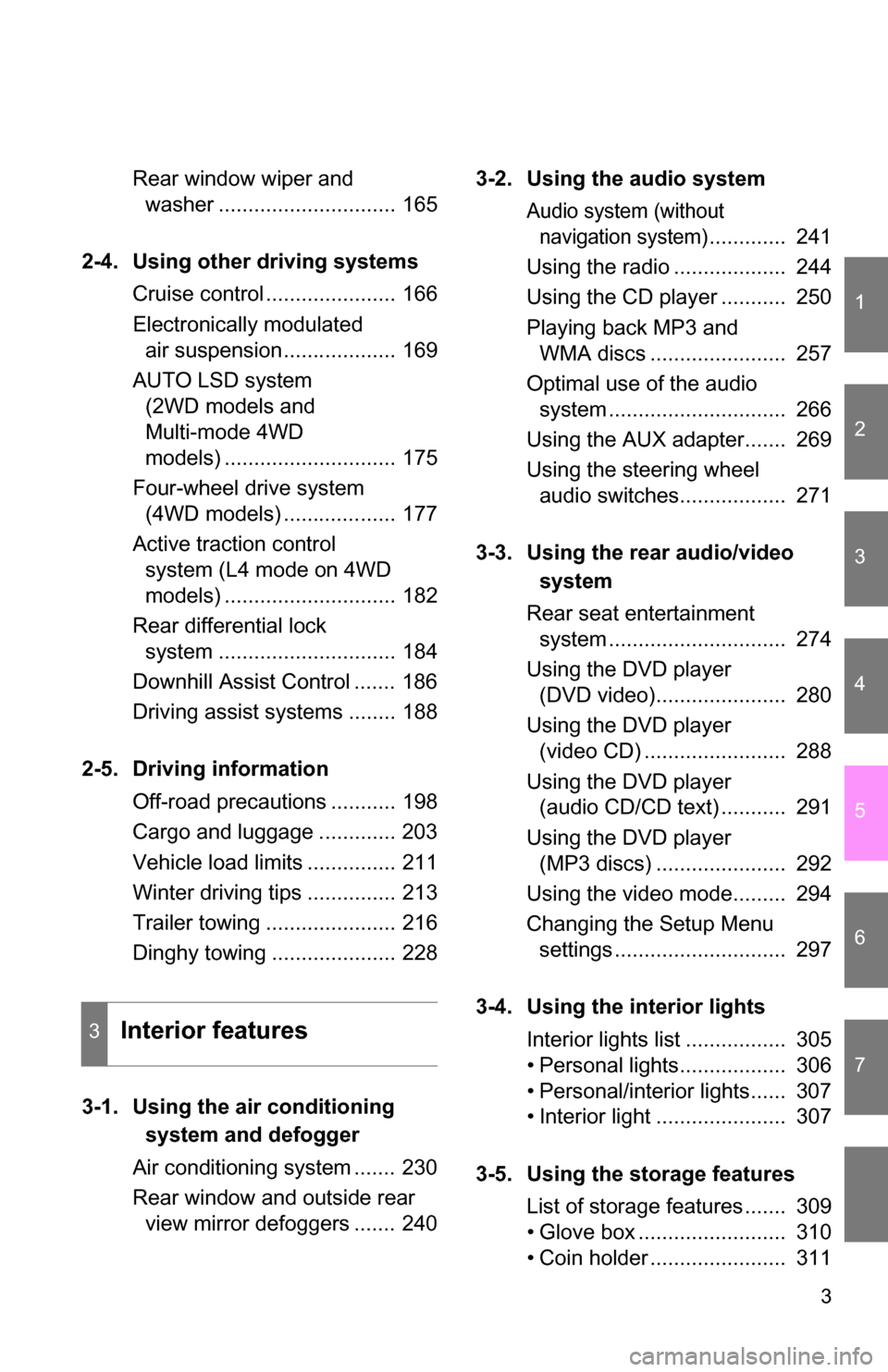
1
2
3
4
5
6
7
3
Rear window wiper and washer .............................. 165
2-4. Using other driving systems Cruise control ...................... 166
Electronically modulated air suspension................... 169
AUTO LSD system (2WD models and
Multi-mode 4WD
models) ............................. 175
Four-wheel drive system (4WD models) ................... 177
Active traction control system (L4 mode on 4WD
models) ............................. 182
Rear differential lock system .............................. 184
Downhill Assist Control ....... 186
Driving assist systems ........ 188
2-5. Driving information Off-road precautions ........... 198
Cargo and luggage ............. 203
Vehicle load limits ............... 211
Winter driving tips ............... 213
Trailer towing ...................... 216
Dinghy towing ..................... 228
3-1. Using the air conditioning
system a nd defogger
Air conditioning system ....... 230
Rear window and outside rear view mirror defoggers ....... 240 3-2. Using the audio system
Audio system (without
navigation system)
............. 241
Using the radio ................... 244
Using the CD player ........... 250
Playing back MP3 and WMA discs ....................... 257
Optimal use of the audio system .............................. 266
Using the AUX adapter....... 269
Using the steering wheel audio switches.................. 271
3-3. Using the rear audio/video
system
Rear seat entertainment system .............................. 274
Using the DVD player (DVD video)...................... 280
Using the DVD player (video CD) ........................ 288
Using the DVD player (audio CD/CD text) ........... 291
Using the DVD player (MP3 discs) ...................... 292
Using the video mode......... 294
Changing the Setup Menu settings ............................. 297
3-4. Using the interior lights Interior lights list ................. 305
• Personal lights.................. 306
• Personal/interior lights...... 307
• Interior light ...................... 307
3-5. Using the storage features List of storage features ....... 309
• Glove box ......................... 310
• Coin holder ....................... 311
3Interior features
Page 131 of 520

When driving2
131
2-1. Driving proceduresDriving the vehicle............ 132
Engine (ignition) switch .... 140
Automatic
Transmission.... 143
Turn signal lever .............. 145
Parking brake ................... 146
Horn ................................. 147
2-2. Instrument cluster Gauges and meters ......... 148
Indicators and warning lights .............................. 151
Accessory meter .............. 155
2-3. Operating the lights and wipers
Headlight switch ............... 158
Fog light switch ................ 162
Windshield wipers and washer ........................... 163
Rear window wiper and washer ........................... 165 2-4. Using other driving systems
Cruise control ................... 166
Electronically modulated air suspension ................ 169
AUTO LSD system (2WD models and
Multi-mode 4WD
models) .......................... 175
Four-wheel drive system (4WD models) ................ 177
Active traction control system (L4 mode on
4WD models) ................. 182
Rear differential lock system ........................... 184
Downhill Assist Control .... 186
Driving assist systems ..... 188
2-5. Driving information Off-road precautions ........ 198
Cargo and luggage .......... 203
Vehicle load limits ............ 211
Winter driving tips ............ 213
Trailer towing ................... 216
Dinghy towing .................. 228
Page 139 of 520
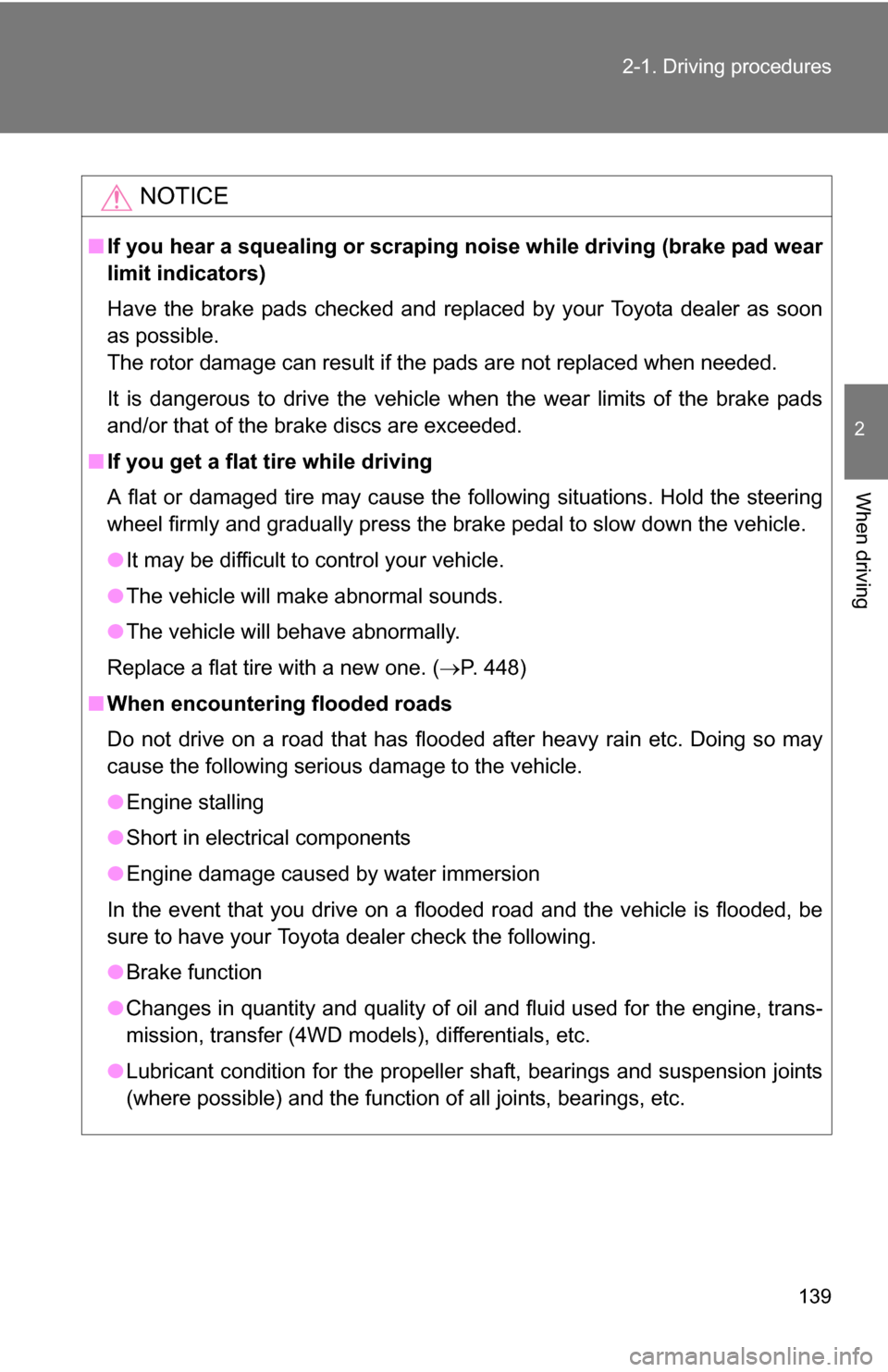
139
2-1. Driving procedures
2
When driving
NOTICE
■
If you hear a squealing or scrapin g noise while driving (brake pad wear
limit indicators)
Have the brake pads checked and replaced by your Toyota dealer as soon
as possible.
The rotor damage can result if the pads are not replaced when needed.
It is dangerous to drive the vehicle when the wear limits of the brake pads
and/or that of the brake discs are exceeded.
■ If you get a flat tire while driving
A flat or damaged tire may cause the following situations. Hold the steering
wheel firmly and gradually press the brake pedal to slow down the vehicle.
●It may be difficult to control your vehicle.
● The vehicle will make abnormal sounds.
● The vehicle will behave abnormally.
Replace a flat tire with a new one. ( P. 448)
■ When encountering flooded roads
Do not drive on a road that has flooded after heavy rain etc. Doing so may
cause the following serious damage to the vehicle.
●Engine stalling
● Short in electrical components
● Engine damage caused by water immersion
In the event that you drive on a flooded road and the vehicle is flooded, be
sure to have your Toyota dealer check the following.
● Brake function
● Changes in quantity and quality of oil and fluid used for the engine, trans-
mission, transfer (4WD models), differentials, etc.
● Lubricant condition for the propeller shaft, bearings and suspension joints
(where possible) and the function of all joints, bearings, etc.
Page 144 of 520
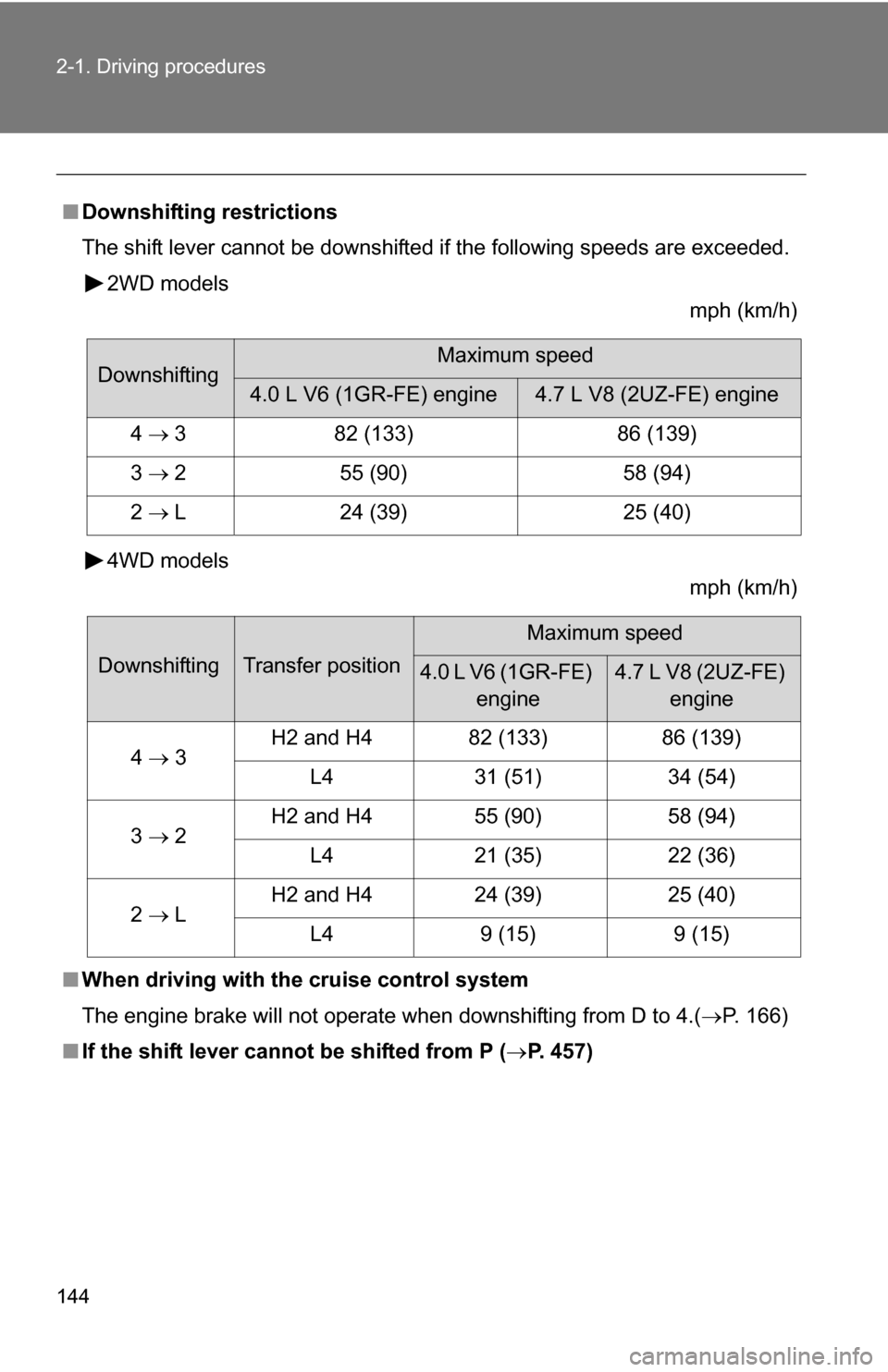
144 2-1. Driving procedures
■Downshifting restrictions
The shift lever cannot be downshifted if the following speeds are exceeded.
2WD models mph (km/h)
4WD models mph (km/h)
■ When driving with the cruise control system
The engine brake will not operate when downshifting from D to 4.( P. 166)
■ If the shift lever cannot be shifted from P (P. 457)
DownshiftingMaximum speed
4.0 L V6 (1GR-FE) engine4.7 L V8 (2UZ-FE) engine
4 3 82 (133) 86 (139)
3 2 55 (90) 58 (94)
2 L 24 (39) 25 (40)
DownshiftingTransfer position
Maximum speed
4.0 L V6 (1GR-FE)
engine4.7 L V8 (2UZ-FE) engine
4 3 H2 and H4 82 (133) 86 (139)
L4 31 (51) 34 (54)
3 2 H2 and H4 55 (90) 58 (94)
L4 21 (35) 22 (36)
2 L H2 and H4 24 (39) 25 (40)
L4 9 (15) 9 (15)
Page 153 of 520
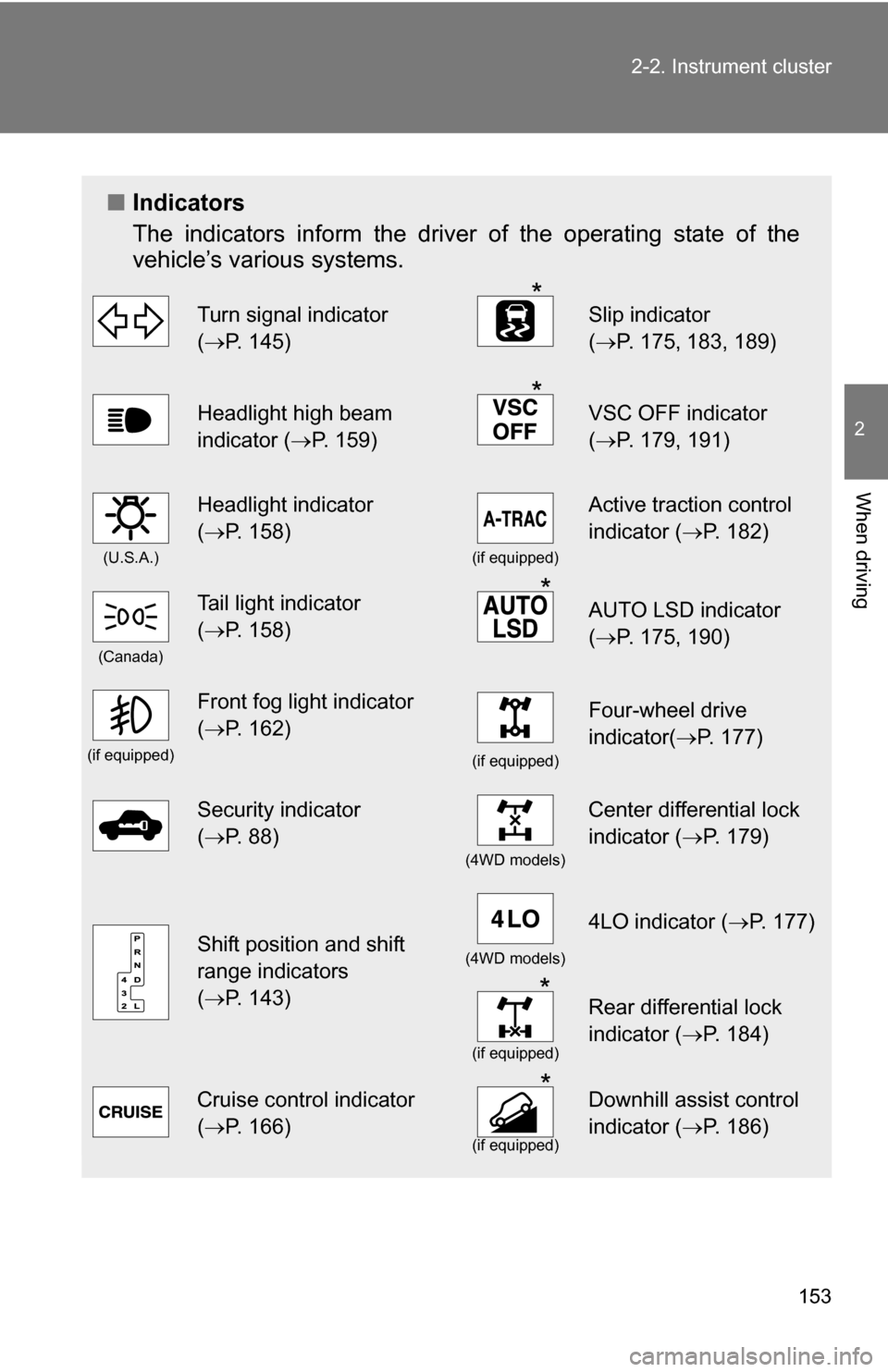
153
2-2. Instrument cluster
2
When driving
■
Indicators
The indicators inform the driver of the operating state of the
vehicle’s various systems.
Turn signal indicator
(P. 145)*Slip indicator
( P. 175, 183, 189)
Headlight high beam
indicator ( P. 159)*VSC OFF indicator
(P. 179, 191)
(U.S.A.)
Headlight indicator
(P. 158)
(if equipped)
Active traction control
indicator ( P. 182)
(Canada)
Tail light indicator
(P. 158) *AUTO LSD indicator
( P. 175, 190)
(if equipped)
Front fog light indicator
(P. 162)
(if equipped)
Four-wheel drive
indicator( P. 177)
Security indicator
(P. 88)
(4WD models)
Center differential lock
indicator ( P. 179)
Shift position and shift
range indicators
(P. 143)(4WD models)
4LO indicator ( P. 177)
*
(if equipped)
Rear differential lock
indicator (P. 184)
Cruise control indicator
(P. 166) *
(if equipped)
Downhill assist control
indicator ( P. 186)
Page 175 of 520

175
2-4. Using other driving systems
2
When driving
AUTO LSD system (2WD models and Multi-mode 4WD models)
The AUTO LSD system aids traction by using the traction control
system to control engine performance and braking when one of the
rear wheels begins to spin.
The system should be used only wh en one of the rear wheels spin-
ning occurs in a ditch or rough surface.
■ System operation
The system can be used on 2W D models and in 2WD mode on
4WD models.
The system is activated when dr iving at a speed under 62 mph
(100 km/h).
Press the VSC OFF switch to
turn on the system.
At this time, the AUTO LSD
and slip indicators will come
on.
To turn off the system, push
the switch again.
If the engine is turned off while
the AUTO LSD and slip indica-
tors are on and then restarted,
the indicator will turn off auto-
matically.
Page 177 of 520

177
2-4. Using other driving systems
2
When driving
Four-wheel drive system (4WD models)
Use the four-wheel drive control switch and center differential lock
switch to select the following transfer and center differential modes.
■ Four-wheel drive control switch
Multi-mode 4WD models
H2 (high speed position,
two-wheel drive)
Normal driving
H4 (high speed position,
four-wheel drive)
Greater traction than two
wheel drive.
When you experience a
loss of power, such as
wheel slipping.
The four-wheel drive indi-
cator will come on.
L4 (low speed position,
four-wheel drive)
Driving requiring maximum
power and traction such as
climbing or descending
steep hills, off-road driving,
and hard pulling in sand or
mud, etc.
The four-wheel drive and
4LO indicators will come
on.
Page 178 of 520
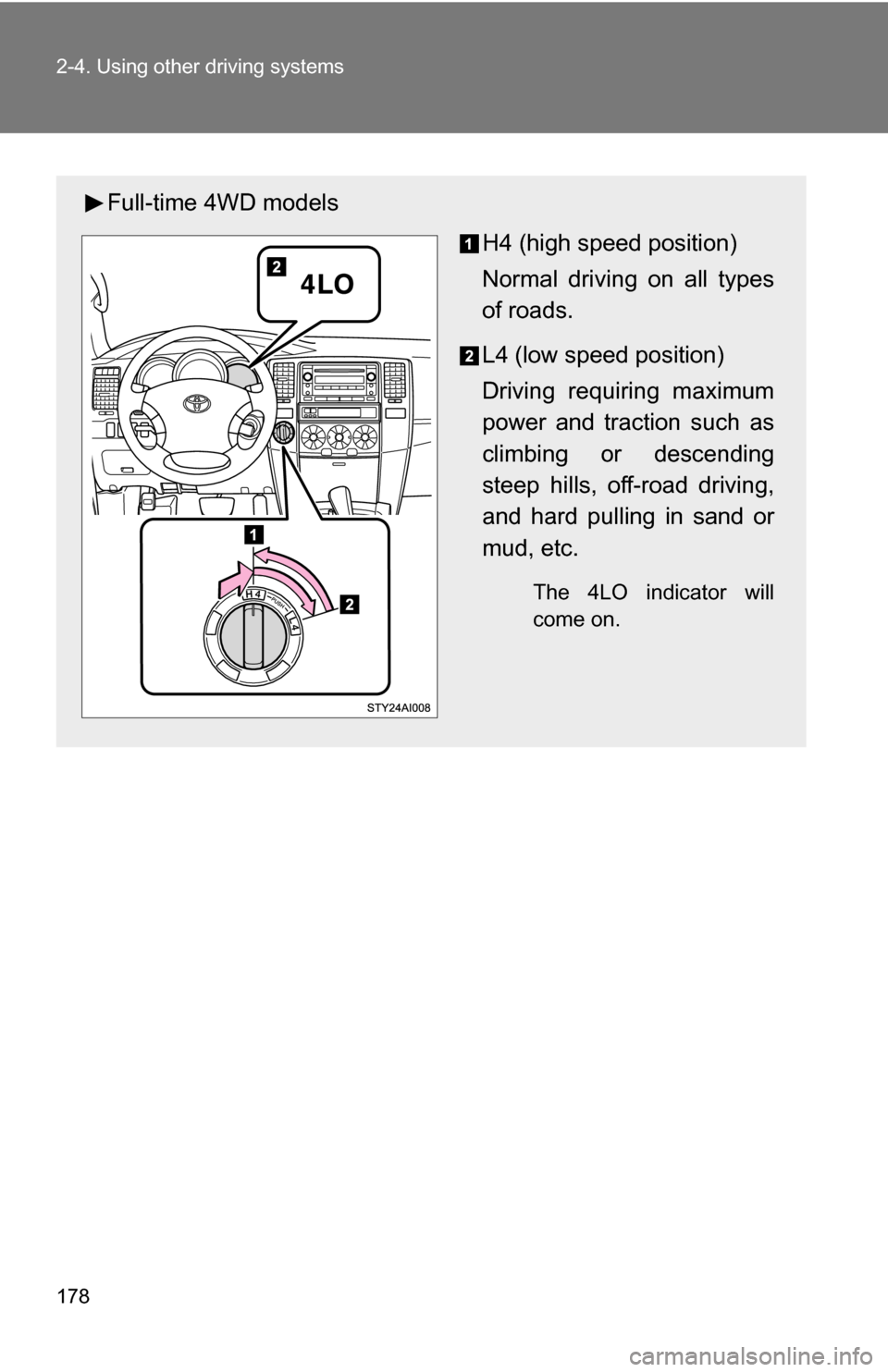
178 2-4. Using other driving systems
Full-time 4WD modelsH4 (high speed position)
Normal driving on all types
of roads.
L4 (low speed position)
Driving requiring maximum
power and traction such as
climbing or descending
steep hills, off-road driving,
and hard pulling in sand or
mud, etc.
The 4LO indicator will
come on.
Page 180 of 520
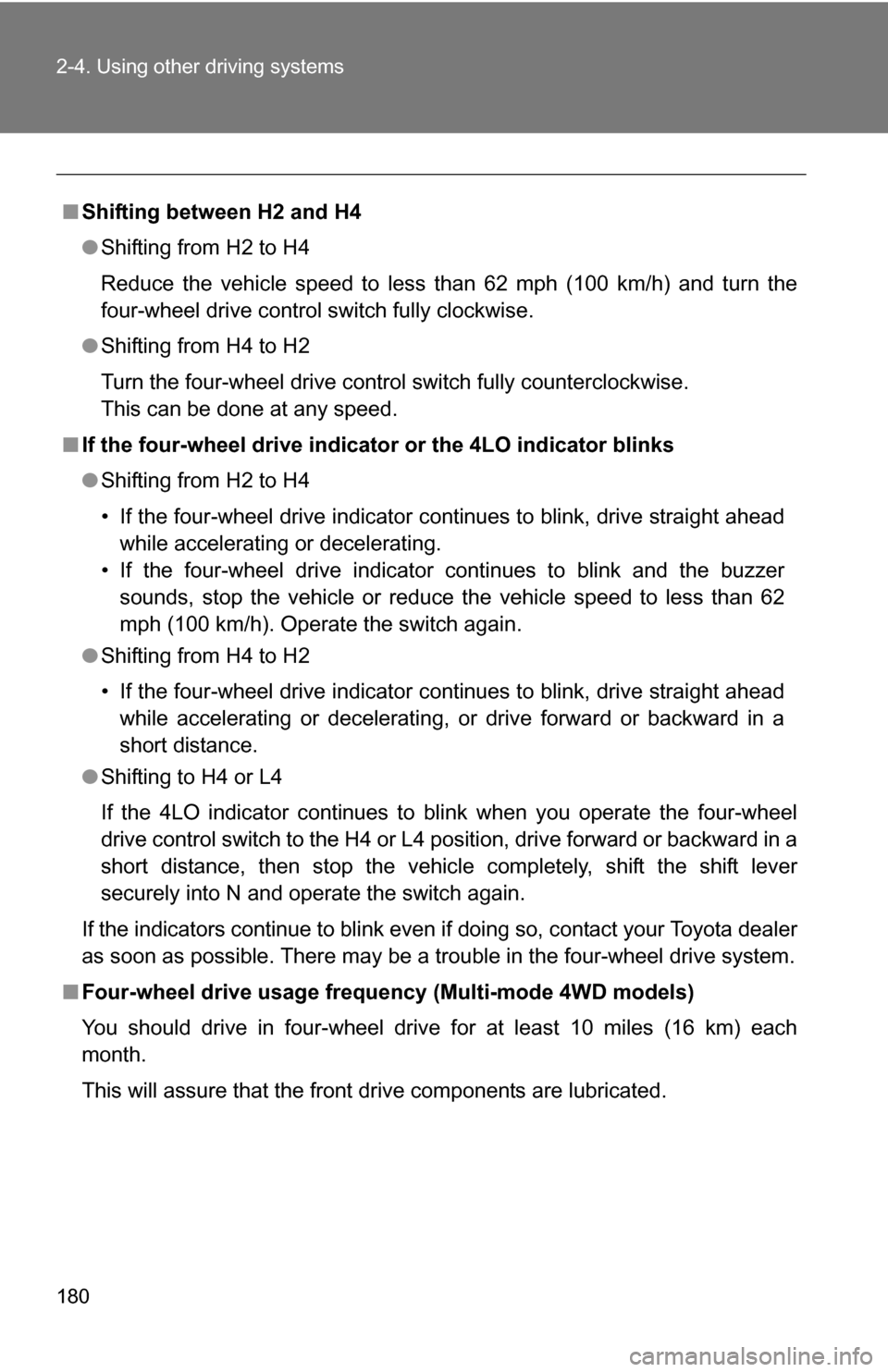
180 2-4. Using other driving systems
■Shifting between H2 and H4
●Shifting from H2 to H4
Reduce the vehicle speed to less than 62 mph (100 km/h) and turn the
four-wheel drive control switch fully clockwise.
● Shifting from H4 to H2
Turn the four-wheel drive control switch fully counterclockwise.
This can be done at any speed.
■ If the four-wheel drive indicat or or the 4LO indicator blinks
● Shifting from H2 to H4
• If the four-wheel drive indicator continues to blink, drive straight ahead
while accelerating or decelerating.
• If the four-wheel drive indicator continues to blink and the buzzer sounds, stop the vehicle or reduce the vehicle speed to less than 62
mph (100 km/h). Operate the switch again.
● Shifting from H4 to H2
• If the four-wheel drive indicator continues to blink, drive straight ahead
while accelerating or decelerating, or drive forward or backward in a
short distance.
● Shifting to H4 or L4
If the 4LO indicator continues to blink when you operate the four-wheel
drive control switch to the H4 or L4 position, drive forward or backward in a
short distance, then stop the vehicle completely, shift the shift lever
securely into N and operate the switch again.
If the indicators continue to blink even if doing so, contact your Toyota dealer
as soon as possible. There may be a trouble in the four-wheel drive system.
■ Four-wheel drive usage freque ncy (Multi-mode 4WD models)
You should drive in four-wheel drive for at least 10 miles (16 km) each
month.
This will assure that the front drive components are lubricated.
Page 182 of 520
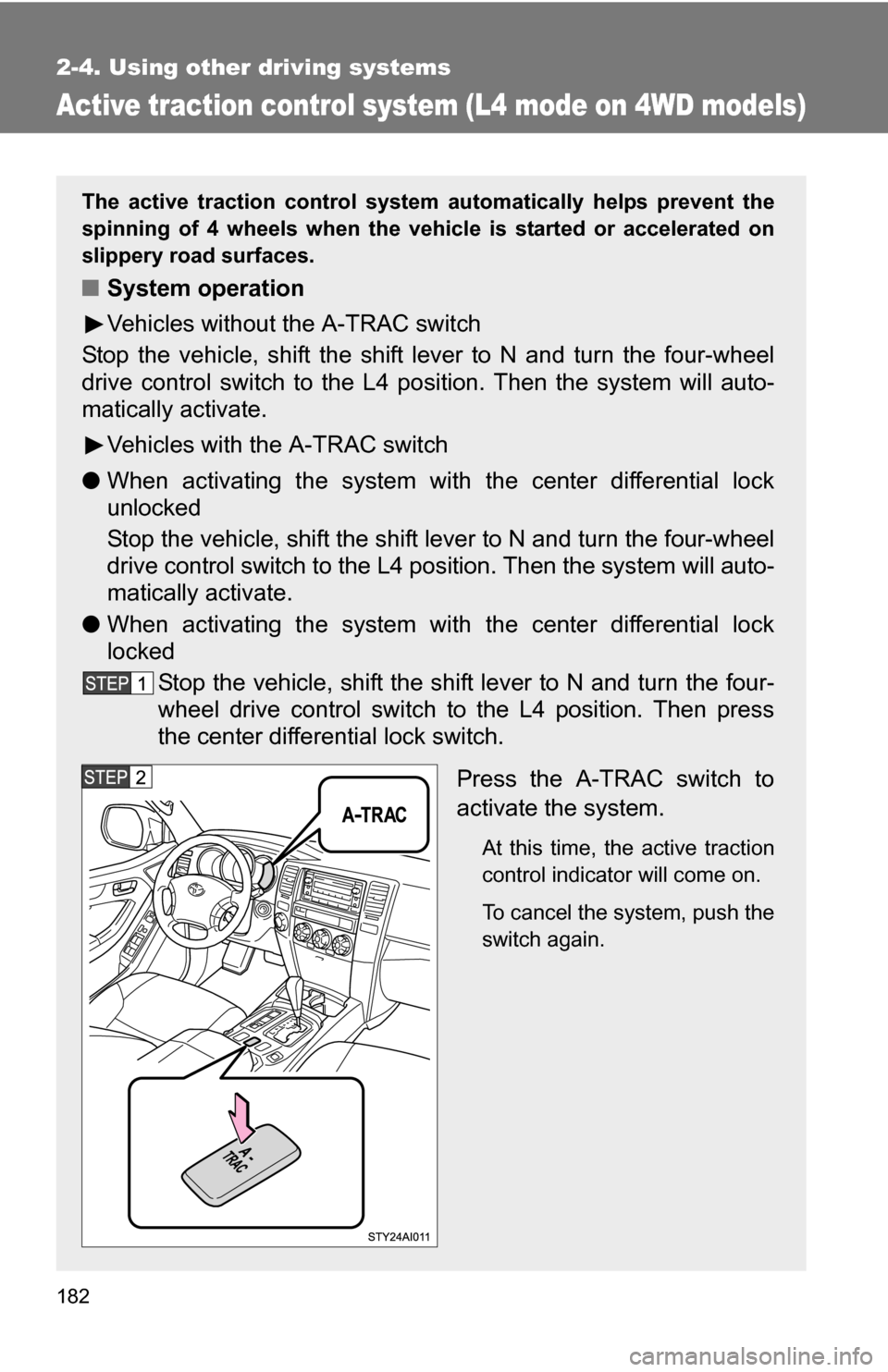
182
2-4. Using other driving systems
Active traction control system (L4 mode on 4WD models)
The active traction control system automatically helps prevent the
spinning of 4 wheels when the vehicle is started or accelerated on
slippery road surfaces.
■ System operation
Vehicles without the A-TRAC switch
Stop the vehicle, shift the shift lever to N and turn the four-wheel
drive control switch to the L4 po sition. Then the system will auto-
matically activate.
Vehicles with the A-TRAC switch
● When activating the system with the center differential lock
unlocked
Stop the vehicle, shift the shift lever to N and turn the four-wheel
drive control switch to the L4 position. Then the system will auto-
matically activate.
● When activating the system with the center differential lock
locked
Stop the vehicle, shift the shift lever to N and turn the four-
wheel drive control switch to the L4 position. Then press
the center differential lock switch.
Press the A-TRAC switch to
activate the system.
At this time, the active traction
control indicator will come on.
To cancel the system, push the
switch again.